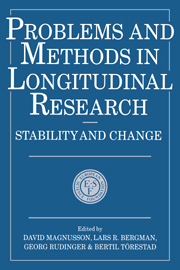Book contents
- Frontmatter
- Contents
- Contributors to this volume
- Foreword
- Preface
- 1 Studying individual development: problems and methods
- 2 Modeling individual and average human growth data from childhood to adulthood
- 3 Intraindividual variability in older adults' depression scores: some implications for developmental theory and longitudinal research
- 4 Now you see it, now you don't – some considerations on multiple regression
- 5 Differential development of health in a life-span perspective
- 6 Assessing change in a cohort-longitudinal study with hierarchical data
- 7 Statistical and conceptual models of ‘turning points’ in developmental processes
- 8 Qualitative analyses of individual differences in intra- individual change: examples from cognitive development
- 9 Application of correspondence analysis to a longitudinal study of cognitive development
- 10 Event-history models in social mobility research
- 11 Behavioral genetic concepts in longitudinal analyses
- 12 Genetic and environmental factors in a developmental perspective
- 13 Structural equation models for studying intellectual development
- 14 Longitudinal studies for discrete data based on latent structure models
- 15 Stability and change in patterns of extrinsic adjustment problems
- Index
9 - Application of correspondence analysis to a longitudinal study of cognitive development
Published online by Cambridge University Press: 27 April 2010
- Frontmatter
- Contents
- Contributors to this volume
- Foreword
- Preface
- 1 Studying individual development: problems and methods
- 2 Modeling individual and average human growth data from childhood to adulthood
- 3 Intraindividual variability in older adults' depression scores: some implications for developmental theory and longitudinal research
- 4 Now you see it, now you don't – some considerations on multiple regression
- 5 Differential development of health in a life-span perspective
- 6 Assessing change in a cohort-longitudinal study with hierarchical data
- 7 Statistical and conceptual models of ‘turning points’ in developmental processes
- 8 Qualitative analyses of individual differences in intra- individual change: examples from cognitive development
- 9 Application of correspondence analysis to a longitudinal study of cognitive development
- 10 Event-history models in social mobility research
- 11 Behavioral genetic concepts in longitudinal analyses
- 12 Genetic and environmental factors in a developmental perspective
- 13 Structural equation models for studying intellectual development
- 14 Longitudinal studies for discrete data based on latent structure models
- 15 Stability and change in patterns of extrinsic adjustment problems
- Index
Summary
Our aim in this chapter is to illustrate in what way the constraints inherent in a specific problem motivate the choice of a particular method to analyze longitudinal research data. The problem examined here is the form of intraindividual variability in level of cognitive development, and stability or changes in this form over time. The method is correspondence analysis. The data used for the purposes of illustration chapter are drawn from a longitudinal study by J. Lautrey, A. de Ribaupierre and L. Rieben. This chapter focuses mainly on methodological issues; more detailed information on the study itself can be found elsewhere, for example in Lautrey, de Ribaupierre & Rieben (1985, 1986), de Ribaupierre, Rieben & Lautrey (1985), Rieben, de Ribaupierre & Lautrey (1983). The first main section of the chapter examines methodological constraints related to the theoretical issues and the nature of the data. The second section is devoted to correspondence analysis and presents the features which make it particularly suited to handling these constraints. The third section deals with the results obtained by correspondence analysis and discusses the implications of some methodological choices.
CONSTRAINTS INHERENT TO THE NATURE OF THE PROBLEM
Theoretical issues
The central issue in this study is the form of cognitive development. In other words, does knowledge acquisition adhere to an invariant sequence which is identical for all children, or can cognitive development follow different pathways for different children? In terms of data analysis, such different developmental pathways are inferred from interindividual differences in the form of intraindividual variability.
- Type
- Chapter
- Information
- Problems and Methods in Longitudinal ResearchStability and Change, pp. 190 - 211Publisher: Cambridge University PressPrint publication year: 1991



